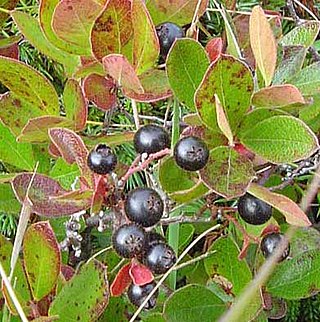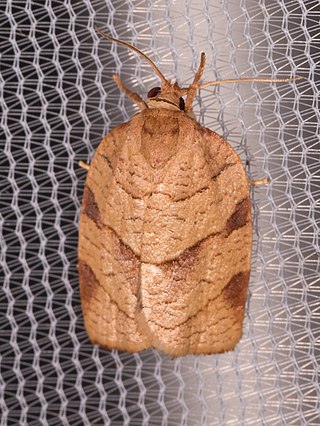
Gaylussacia is a genus of about fifty species of flowering plants in the family Ericaceae, native to the Americas, where they occur in eastern North America and in South America in the Andes and the mountains of southeastern Brazil. Common English names include huckleberry and "dangleberry".

The Coleophoridae are a family of small moths, belonging to the huge superfamily Gelechioidea. Collectively known as case-bearers, casebearing moths or case moths, this family is represented on all continents, but the majority are found in temperate areas of the Northern Hemisphere. They are most common in the Palearctic, and rare in sub-Saharan Africa, South America, and Australia; consequently, they probably originated in northern Eurasia. They are relatively common in houses, they seek out moist areas to rest and procreate.

Coleophora is a very large genus of moths of the family Coleophoridae. It contains some 1,350 described species. The genus is represented on all continents, but the majority are found in the Nearctic and Palaearctic regions. Many authors have tried splitting the genus into numerous smaller ones, but most of these have not become widely accepted.
Hoverter and Sholl Box Huckleberry Natural Area is a 10-acre (4.0 ha) natural area in Perry County, Pennsylvania, near New Bloomfield, which protects a colony of box huckleberry over 1,000 years old. The smallest Natural Area in Pennsylvania, it is administered as part of Tuscarora State Forest. It was designated a National Natural Landmark in April 1967.

Gaylussacia brachycera, commonly known as box huckleberry or box-leaved whortleberry, is a low North American shrub related to the blueberry and the other huckleberries. It is native to the east-central United States.

Huckleberry is a name used in North America for several plants in the family Ericaceae, in two closely related genera: Vaccinium and Gaylussacia.

Coleophora vestianella is a moth of the family Coleophoridae. It is found from Europe to Asia Minor, Iran, Afghanistan, China, the Korean Peninsula and Japan.

Coleophora anatipennella is a moth of the case-bearer family (Coleophoridae).

The trefoil thick-horned tinea or large clover case-bearer is a moth of the family Coleophoridae. It is found in Europe, North Africa, Asia Minor, Afghanistan and North America.
Phyllonorycter diversella is a moth of the family Gracillariidae. It is known from Nova Scotia in Canada and Connecticut, Ohio, Kentucky, Maine and Vermont in the United States.
Coleophora hungariae is a moth of the family Coleophoridae. It is found in Austria, Bulgaria, Hungary, Romania, Slovakia and southern Russia.
Coleophora sacramenta is a moth of the family Coleophoridae. It is found in the United States, including California.
Coleophora multicristatella is a moth of the family Coleophoridae. It is found in Canada, including Nova Scotia.
Coleophora umbratica is a moth of the family Coleophoridae. It is found in the United States, including Ohio.
Coleophora paludoides is a moth of the family Coleophoridae. It is found in Canada, including Ontario.

Coleophora cratipennella, the streaked coleophora moth, is a moth of the family Coleophoridae. It is found in the United States, including Kentucky, Pennsylvania, California, Maine and Oklahoma.

Coleophora texanella is a moth of the family Coleophoridae. It is found in the United States, where it has been recorded from Florida to California, north to New York, Michigan and Ohio, west to Kansas and also in Mexico. It has also been recorded from Bermuda and Europe, where it is found in Italy and in Greece.
Coleophora argentialbella is a moth of the family Coleophoridae. It is found in the United States, including Kentucky and Oklahoma.

Choristoneura obsoletana is a species of moth of the family Tortricidae. It is found in the United States, where it has been recorded from Alabama, Arkansas, California, Florida, Illinois, Kansas, Louisiana, Maine, Massachusetts, Mississippi, Missouri, New Mexico, North Carolina, Ohio, Oklahoma, Oregon, South Carolina, Tennessee, Virginia and West Virginia.

Gaylussacia bigeloviana, also known as the Northern Dwarf Huckleberry (English) or the Gaylussaquier de Bigelow (French), is a plant species native to the coastal plains of eastern Canada and the eastern United States. It grows from Newfoundland to South Carolina in swamps and marshes, including acidic bogs alongside Sphagnum peatmosses.










